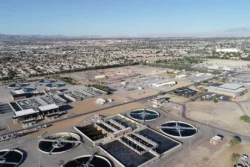
Wastewater Treatment Classes
Understanding Wastewater Treatment Classes: Significance, Types, and Techniques
Wastewater treatment is a critical component of modern infrastructure, playing a vital role in protecting public health and preserving the environment. As urbanization and industrial activities continue to increase, the demand for effective wastewater management systems has never been more pressing. According to the United Nations, about 80% of all wastewater generated globally is discharged into the environment without adequate treatment, causing severe health and environmental issues. This article will delve into the various wastewater treatment classes, their significance, operational methodologies, and future trends, ensuring that facility managers, environmental engineers, and wastewater professionals obtain a comprehensive understanding of this essential field.
Importance of Wastewater Treatment
Wastewater treatment is essential not only for protecting human health but also for promoting environmental sustainability. Contaminated water can lead to the spread of waterborne diseases, adversely affecting millions in both developed and developing nations. For instance, research published in the journal Environmental Health Perspectives indicates that around 2.5 billion people globally lack access to improved sanitation, leading to approximately 1.5 million child deaths each year from diarrhea-related diseases.
Furthermore, untreated wastewater can contaminate freshwater sources, endangering aquatic ecosystems and making resources unavailable for safe agricultural and drinking water use. Effective wastewater management helps mitigate these risks, promotes public health, and fosters environmental protection.
Sections of Wastewater Treatment Classes
The concept of wastewater treatment can generally be broken down into several classes or categories, each with unique processes and technologies. Below, we will explore four primary classes of wastewater treatment:
- Preliminary Treatment
- Primary Treatment
- Secondary Treatment
- Tertiary Treatment and Advanced Treatment Options
1. Preliminary Treatment
Preliminary treatment represents the first stage in the wastewater treatment process. Its primary aim is to remove debris and large solids that could damage subsequent treatment equipment.
Key Processes
- Screening: This process involves removing large items such as sticks, plastics, and other debris using mechanical screens.
- Grit Removal: Grit chambers allow heavy particles like sand and gravel to settle out, preventing damage to pumps and equipment.
- Flow Equalization: This technique smooths out flow variations, ensuring consistent treatment rates regardless of the inflow volume.
Data Insights
According to industry reports, adequate preliminary treatment can remove up to 50% of total suspended solids (TSS), significantly enhancing the efficiency of downstream processes.
2. Primary Treatment
The primary treatment phase focuses on separating settleable organic and inorganic solids from wastewater.
Key Processes
- Sedimentation: In sedimentation basins, gravity allows pollutants to settle as sludge, leaving behind relatively clearer liquid.
- Floating Material Removal: Skimming mechanisms remove oils and fats that float to the surface.
Effectiveness
Statistical analyses show that primary treatment can remove about 60% of TSS and up to 30% of biochemical oxygen demand (BOD), which measures the organic material in wastewater.
3. Secondary Treatment
Secondary treatment is the biological stage, where microorganisms are employed to degrade organic matter dissolved in wastewater, resulting in a cleaner effluent.
Key Processes
- Aerobic Digestion: This involves introducing oxygen to help aerobic microorganisms break down organic pollutants. Techniques such as activated sludge systems and bioflocculation are commonly implemented.
- Anaerobic Digestion: Often used for solid waste, anaerobic processes occur in oxygen-free environments, producing biogas as a byproduct.
Technological Trends
According to a report by the International Water Association, investment in secondary treatment technologies is projected to grow by over 7% annually through 2025, driven by the increasing need for sustainability and resource recovery.
4. Tertiary Treatment and Advanced Treatment Options
Tertiary treatment focuses on further polishing the effluent and removing residual impurities. It’s particularly important when the effluent is intended for reuse.
Key Processes
- Filtration: Sand filters, membrane filtration, and microfiltration are common techniques used to remove remaining particulates.
- Chemical Treatment: Advanced methods often include the use of chemicals such as chlorine or ozone for disinfection purposes.
- Reverse Osmosis: This process effectively removes dissolved salts and other small contaminants, making it essential for potable water purposes.
Importance of Tertiary Treatment
Research indicates that tertiary treatment can reduce pathogens and nutrient loads by 95%, crucial for maintaining ecological balance and safeguarding public health.
Addressing Common Questions
Q: How long does the wastewater treatment process take?
A: The duration of wastewater treatment varies widely. Preliminary and primary treatment can take hours to days, whereas secondary treatment may last several days depending on the technology applied.
Q: What happens to the sludge produced during treatment?
A: Sludge is typically treated to reduce its volume and stabilize organic matter. It can be disposed of through incineration, landfilling, or used as agricultural fertilizer after processing.
Q: What are the main regulations governing wastewater treatment?
A: Various regulations apply, including the Clean Water Act in the U.S. and EU Water Framework Directive in Europe. Compliance with these regulations is crucial to ensuring effective wastewater management.
Conclusion
The effective treatment of wastewater is a multi-faceted process that plays a crucial role in safeguarding public health and ensuring environmental integrity. Understanding the different classes of wastewater treatment, from preliminary to advanced methods, provides valuable insights for professionals in the field. As global water scarcity issues intensify, the need for efficient treatment processes will only grow, necessitating ongoing investment in innovative technologies and methods. By equipping facility managers and wastewater professionals with comprehensive knowledge, we can collectively advance toward a more sustainable future, ensuring that wastewater is treated effectively and responsibly.
In this regard, staying updated with the latest research, industry trends, and regulatory requirements is essential for maintaining effective and compliant wastewater treatment operations.
